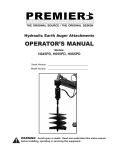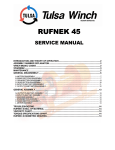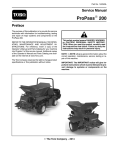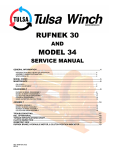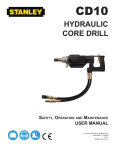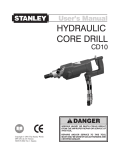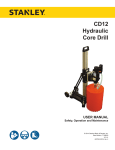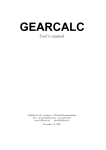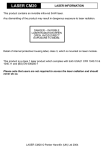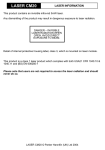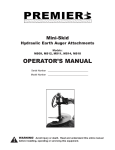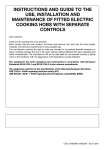Download Premier Augers - S.D.P. Manufacturing, Inc.
Transcript
Premier Augers 1631 East Pontiac Street Fort Wayne, IN 46803 866-458-0008 Hydraulic Earth Auger Operator’s Manual Serial Number_____________ Model Number_____________ Models H005PD, H010PD, H015PD, H019PD, H024PD Warning Avoid Injury Or Death Read And Understand This Entire Manual Before Installing, Operating Or Servicing This Equipment Table Of Contents Safety Information THE USE OF THIS EQUIPMENT IS SUBJECT TO CERTAIN HAZZARDS, WHICH CANNOT BE PROTECTED AGAINST MECHANICAL MEANS OR PRODUCT DESIGN. ALL OPERATORS OF THIS EQUIPMENT MUST READ AND UNDERSTAND THIS ENTIRE MANUAL, PAYING PATICULAR ATTENTION TO SAFETY AND OPERATING INSTRUCTIONS, PRIOR TO USING THE PREMIER AUGERS HYDRAULIC EARTH AUGER. IF THERE IS SOMETHING IN THIS MANUAL YOU DO NOT UNDERSTAND, ASK YOUR SUPERVISOR TO EXPLAIN IT TO YOU. FAILURE TO OBSERVE THESE SAFETY PRECAUTIONS CAN RESULT IN DEATH OR SERIOUS INJURY OR SERIOUS EQUIPMENT DAMAGE. 1. All bystanders should be kept a minimum of 10 feet away from working area of the earth auger. 2. Always wear an OSHA approved hard hat and safety eye protection when operating or servicing this equipment. Do not wear loose fitting clothing, flopping cuffs, dangling neckties and scarves, or rings and wrist watches that can catch moving parts. 3. An operator must not use drugs or alcohol, which can change his alertness or coordination. An operator taking prescription or over the counter drugs should seek medical advice on whether or not he can safely operate equipment. 4. Always locate underground electrical wires, telephone cables, and gas, water, and sewer lines before digging. Maintain safe clearance and avoid contact with any underground or overhead utility lines or electrically charged conductors. 5. Never alter or remove any safety decals or safety shields. Check this manual for location of these items and replace immediately if damaged or illegible. 6. Never adjust a relief valve for pressure higher than recommended by vehicle manufacturer. 7. Whenever changing or installing this or other attachments, make sure all connections are securely fastened. 8. Travel only with the earth auger in a safe transport position to prevent uncontrolled movement. Drive slowly over rough ground and on slopes. Tether earth auger with a chain, if necessary, to prevent uncontrolled swinging of earth auger when moving from hole to hole. Remove earth auger from vehicle when transporting to and from job site. 2 9. Before exiting vehicle, lower earth auger to ground, turn off vehicle engine and lock vehicle breaks. 10.Never check a pressurized system for leaks with your bare hand. Oil escaping from pinhole leaks under pressure can penetrate skin and could cause serious infection. Hold a piece of cardboard up next to suspected leaks and wear a face shield or safety eye protection. If any fluid is injected into the skin, it must be removed immediately by a doctor familiar with this type of injury. 11.Before disconnecting hydraulic lines or fittings be sure to relieve all pressure by cycling all hydraulic controls after shutdown. Remember hydraulic systems are under pressure whenever the engine is running and may hold pressure after shutdown. Before applying pressure to the system make sure all connections are tight and that there is no damage to lines, fittings, and hoses. 12.Flow and pressure gauges, fitting, and hoses must have a continuous operating pressure rating of at least 25% higher than highest pressures of the system. 13.Avoid steep hillside operation, which could cause the vehicle to overturn. Consult your vehicle operator’s and safety manuals for the maximum incline allowable. 14.Never perform any work on an earth auger unless you are authorized and qualified to do so. Always read the operator service manual before any repair is made. After completing maintenance or repair, check for correct functioning of the earth auger. If not functioning properly always tag “DO NOT OPERATE” until all problems are corrected. 15.This manual covers the safe use, installation, operation, and service instructions for the earth auger only. Always read the operating and safety manuals prepared for your vehicle and any other attachments before using them. 3 H019SDP200 Installation Instructions 1. 40030 2. 40031 3. 91006 4. 91007 5. 60003 6. 61004 7. 61002 8. 61003 9. 65002 10.40009 Long Pin Short Pin Swivel Housing Hydraulic Motor Motor Fittings Check Valve Breather Vent Planetary Snap Pin (Not Shown) 1. READ AND UNDERSTAND ALL SAFETY INFORMATION PRIOR TO ATTEMPTING INSTALLATION. 2. Refer to the “Hydraulic System Hook-up” section in this manual for hydraulic connection instructions and recommendations. 4 Hydraulic System Hook-Up Instructions 1. Once the installation instructions are complete you are now ready to make the hydraulic connections necessary to operate your earth drill. Read and understand safety information prior to making hydraulic connections. 2. Model H019SDP200 requires two ½” I.D. hoses with #10 JIC female fittings on one end of each to connect hoses to drive unit fittings. 3. Once all hydraulic connections have been made and checked for leaks and proper hose lengths, you are now ready to operate your earth drill. Read and understand operating instructions and safety information prior to operating your earth drill. WARNING! HOSES AND FITTINGS MUST HAVE A CONTINUOUS OPERATING PRESSURE RATING OF AT LEAST 25% HIGHER THAN HIGHEST PRESSURES OF THE SYSTEM YOU ARE “TAPPING” INTO. 5 Operating Instructions 1. After all installation instructions have been completed, safety information read and understood and the rest of this operator’s manual has been reviewed, your Hydraulic Earth Drill is now ready to use. 2. With the auger raised off the ground and the vehicle engine set at a low RPM, activate the earth drill control valve to determine position control valve lever must be in to turn auger in a forward (clockwise) rotation. This is the “digging” position. 3. Before beginning to dig, experiment with auger speed to determine a suitable auger RPM. Generally in light and sandy soil a high RPM is desirable. In hard, rocky, or frozen soils a slower RPM is desirable. To increase auger RPM, increase vehicle engine RPM. To decrease auger RPM, decrease vehicle engine RPM. 4. Return earth drill control valve to neutral position to stop the auger. Lower the auger to the ground so that only the center point penetrates the ground about 2”. 5. Activate the earth control valve so auger is turning in a forward (clockwise) rotation. Use only enough down pressure to assure positive penetration of auger into the ground. Ease up on down pressure if auger rotation slows down drastically or stalls. Excessive down pressure will cause the auger to stall frequently. 6. When the auger has penetrated the ground about 24”, raise the auger from the hole to clean the dirt out. Repeat this procedure until the desired hole depth is obtained. 7. Once the required hole depth is reached, allow the auger to turn a few seconds at this depth to clean the hole. 8. Return the earth drill control valve to the neutral position to stop the rotation of the auger. Raise the auger out of the hole, move away from the hole, then activate the earth drill control valve to spin the loose soil off of the augers. 9. If necessary, repeat steps 7 & 8 to obtain a cleaner hole. 10. In some soil conditions or when excessive down pressure is applied, auger may “screw” itself into the ground and become stuck causing earth drill to stall. If this happens, reverse the auger rotation (counter Clockwise) by moving the control valve lever to the reverse position and slowly raise the auger. Once unstuck, return the control valve lever to the forward position and continue digging. 11. If the auger becomes lodged under rocks, roots, or other large obstructions, do not attempt to raise auger out of the ground. See step 10 for proper procedure to relieve the auger. 12. Avoid excessive side loading to the earth drill which can cause drive unit or auger damage. 13.Keep auger teeth and points in good condition. Check frequently and always keep spares on hand so they can be replaced as wear is detected to avoid damage to tooth holders and auger flighting. 6 Maintenance Instructions 1. CLEAN HYDRAULIC OIL IS ESSENTIAL! 80% of all hydraulic component failures are caused by contamination of the hydraulic oil. Always keep all dirt and other contaminates from entering hydraulic system during disconnect and connect operations. Always use dust caps and plugs on all quick disconnects when not in use. Tightly cap all hydraulic openings to hold oil in and keep dirt and other contaminates from entering hydraulic systems. 2. CHECK ALL HYDRAULIC OIL DAILY FOR CONTAMINATION. If contamination is present, determine the source of the problem. 3. INSPECT ALL HYDRAULIC HOSE ASSEMBLIES DAILY for cracked and brittle covers caused by excessive heat. Reduced viscocity of hydraulic oil occurs at higher operating temperatures and causes a breakdown of fluid additives such as wear inhibitors. Excessive heat will cause higher internal leakage in drive unit motor to become brittle and crack. Replacement of hoses before failure will prevent loss of hydraulic oil, time consuming “bleeding” of system, hydraulic oil contamination, and component damage caused by cavitations. It will also reduce the chance of personal injury caused by hydraulic fluid. 4. CHECK AUGER DAILY for loose, worn or broken cutting teeth and point. Worn teeth or point can drastically affect auger penetration and greatly reduce auger life expectancy. Always keep spare teeth and points on hand. Some digging conditions may require checking teeth and point at more frequent intervals. 5. CHECK DRIVE UNIT AND ALL ACCESSORIES DAILY for loose, bent, cracked, or worn, bolts and fasteners. Always use grade 5 or better replacement bolts. Always use lock washers with standard hex nuts or self locking nuts. 6. CHECK ALL CONNECTING PINS DAILY for bends, cracks, breaks, or wear. Replace if any of these conditions exist. 7. CHECK DRIVE UNIT OUTPUT SHAFT DAILY for bends, cracks, breaks, or wear. Replace if any of these conditions exist. 8. CHANGE PLANETARY GEAR REDUCTION OIL AFTER FIRST 50 HOURS OF OPERATION, THEN EVERY 1000 HOURS OR IN ONE YEAR, WHICHEVER COMES FIRST. Use mild extreme pressure lubricant API-GL-5 number 80 or 90 for filling planetary gear reduction under normal temperature ranges between 0 degrees and 120 degrees. Approximate oil capacity for model H019SDP200 is two pints. Check oil level daily to assure proper lubrication is maintained. 9. WHEN STORING DRIVE UNIT for any length of time be sure drive unit motor and hoses are full of clean oil. Also, be sure that planetary gear reduction is full to the recommended capacity for each model as outlined in number 8 above. 10. Drive unit output shaft, inside of auger collar, variable auger extension shaft, inside of variable auger extension collar and all connecting pins should be coated liberally with grease as required to prevent rust and reduce wear. 11. Once paint has been worn off auger, coat liberally with grease as required, to prevent rusting. 12. Check planetary gear oil as follows. Lie drive unit horizontal with ground place bottom drain plug straight up. Remove plug, tilt drive unit at 2:00 or 10:00. Fill until oil leaks out from hole at one of these positions. 7 Troubleshooting Problem Slow Speed Possible Cause Solution Low Flow Check With Flow Meter. If Low Investigate cause. Line Restrictions Clear Lines Fittings Or Connections Too Small Replace With Proper Sizes. Oil Filter Dirty Replace See Dealer For Repair Insufficient Digging Power Hydraulic Pump Worn Or Damaged Worn Teeth Or Point Replace Low System Pressure Check With Pressure Gauge. If Low Investigate Cause. Relief Valve Damaged Or Setting Wrong Adjust Or Replace As Required Excessive Load Reduce Load To Within Machine Specifications Reverse Direction Hoses Reversed Excessive Oil Heating Line Restrictions Oil Leaks Re-Install Hoses Correctly Clear Lines Fluid Dirty Replace Hydraulic Fluid & Filter Insufficient Quantity Of Hydraulic Fluid Hoses Loose Or Damaged Fill Reservoir To Proper Level. Increase Reservoir Storage Capacity. Tighten Or Replace Fittings Loose Or Damaged Tighten Or Replace Hydraulic Motor Seals Worn Or Damaged See Dealer For Repair For Further Assistance, please call your dealer, or contact our sales department as follows: 8 Models H019 Motor Exploded View 9 Model H019SDP200 Parts List Ref.# Part # Description Qty Used On 1 2 3 4 5 7 8 9 10 11 12 13 14 15 16 17 18 19 20 21 22 23 Not Shown 62001 62002 62003 62004 62005 62006 62007 62008 62011 62015 62017 62018 62019 62020 62021 62022 62021 62022 62023 62024 62025 62028 62030 Dust Seal Bearing Housing Seal Back Up Washer Shaft Seal Bearing Shaft Assy Shaft Face Seal Wear Plate Splined Drive Geroler Valve Drive Valve Plate Valve Balancing Ring Outer Face Seal Inner Face Seal Spring Pin Valve Housing Case Drain plug Seal Plug Tie Bolt Seal Kit 1 1 4 1 1 1 1 1 1 1 1 1 1 1 1 1 2 2 1 1 1 4 1 All All All All All All All All H019 H019 All All All All All All All All All All All H019 All Tools Required For Disassembly & Reassembly: Torque Wrench 500 lb. in. Capacity 12-16 Breaker Bar 9/16” Socket Small Screwdriver 6-8 x ¼” Blade 3/16” Allen Wrench Press Shaft Seal Installation Tool 10 Procedures Models H019SDP200 Planetary Exploded View 11 Model H019SDP200 Planetary Parts List Ref# 1 1 2 3 4 5 6 7 8 9 10 11 12 13 14 15 16 17 Part # 69000 69001 69002 69003 69004 69005 69006 69007 69004 69008 69009 69010 69011 69012 69013 69014 69015 69016 Description 2” Hex Output Shaft 2-9/16” Rnd Output Shaft Oil Seal Outer Bearing Cones Bearing Cup Housing Bolt Housing Flat Washer Hub Bearing Cup Inner Bearing Cone Retaining Ring Set Ring Gear Carrier Assembly Sun Gear Thrust Washer Cover Magnetic pipe Plug Top Cover Bolts 12 Qty 1 1 1 1 2 6 6 1 1 1 1 1 1 1 1 1 1 8 Model H019SDP200 Planetary Service Procedure General Instructions: To facilitate the repair of these units and before any work is done, we suggest that you first read all of the steps used in disassembly and assembly of unit. Assembly: 1. Press new bearing cups (4 & 8) into each side of hub (7). It is recommended that the bearing cups (4 & 8) and Cones (3 & 9) be replaced in sets. 2. Assemble bearing cone (3) into cup (4) at seal end of Hub (7). 3. Lubricate lips of oil seal (2) and lower hub (7) onto output shaft (1). Keep hub (7) centered to prevent damage to oil seal (2). 4. Warning! Eye protection should be worn during retaining ring installation. Assemble bearing cone (8) over output shaft (1) and into bearing cup (8). Select the thickest retaining ring (10) that can be assembled into ring groove on output shaft (1) above bearing. Bearings should have from .000 to .006 inches endplay when proper retaining ring (10) is installed. 5. Apply a bead of silicone sealant to face of hub (7) that mates with ring gear (11). 6. Assemble ring gear (11) to hub (7) being careful to align all bolt holes. 7. Install six hex bolts (5) and washers (6). Torque bolts to 52-60 ft/lbs. 8. Place carrier assembly (12) into ring gear (11) aligning the gear teeth. Carrier splines mesh with splines on output shaft (1). Place sun gear (13) into carrier assembly (12). Sun gear (13) should turn freely by hand. 9. Apply a bead of silicone to cover face of ring gear (11). 10. Secure thrust washer (14) with tangs engaged in cover (15). Note: Thrust washer (14) can be secured to cover (15) with a small amount of grease or silicone sealant. Assemble cover (15) to ring gear (11). 11. Install eight bolts (17) and torque to 2025 ft/lbs. 12. Position unit with output shaft pointing down and fill until oil just begins to flow from fill plug (approximately 2 pints). It is important to air blast all parts and wipe them with clean, lint less cloth before assembly. It is a good idea to check all replacement parts closely before installing to ensure that no damage occurred during shipment. Caution If parts are stubborn during assembly, do not force them and never employ an iron hammer. Never hammer bearing cones or cups. Use only an arbor press or other suitable tool. Disassembly: 1. Index mark all sections with a punch. Be sure to align all these marks when reassembling. 2. Remove bolts(17) from cover(15). Lift cover (15) from assembly. Thrust washer (14) usually remains with cover (15). 3. Lift sun gear (13) from carrier assembly (12). Remove carrier assembly (12). 4. Remove 6 hex bolts (5) and washers (6) from hub (7). Pull ring gear (11) from remaining assembly. It may be necessary to strike ring gear (11) with a rubber mallet to loosen from hub (7) 5. Warning! Eye protection should be worn during retaining ring removal. Remove retaining ring (10) from groove in output shaft (1). Pull output shaft (1) from Hub (7). Note: To remove retaining ring use retaining ring expander tool. 6. Remove oil seal (2) and bearing cones (3 & 9) from hub (7). Inspect bearing cups (4 & 8) in hub (7) and remove only if replacement is required. 13













